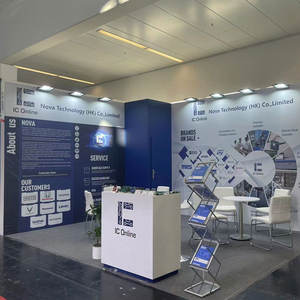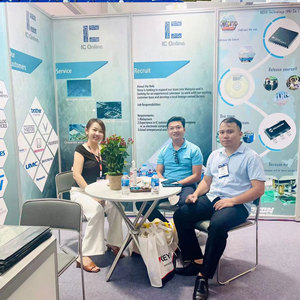
All categories
Featured selections
Trade Assurance
Buyer Central
Help Center
Get the app
Become a supplier

(1620 products available)






































Transistor 2sc refers to a family of hardware. There are variegated types of these equipment, thus knowing them is important.
NPN transistors comprise three layers of semiconductor material, which are n-type, p-type, and again n-type. Out of all the types, this one is the most common as it is applicable in amplifying and switching electrical signals. Its structure leads to the easy flow of electrons from the emitter to the collector when a small current is applied to the base. It makes it ideal for use in digital circuits.
Unlike NPN transistors, in PNP transistors, the layers are arranged oppositely - p-type n-type p-type. These transistors conduct when the current flows out of the base, making them suitable for applications where a positive voltage control is needed. They are used widely in analog circuits and battery-powered devices.
Dual-transistor arrays feature two or more transistors integrated into a single chip. They are often used in applications requiring multiple signal amplification or switching, like in motor control circuits. They save space on the circuit board and ensure simultaneous operation.
For SMD (Surface Mount Device) transistors, instead of the traditional mounting on a circuit board, these transistors are designed for surface-mounting techniques. This type of 2sc transistor is used in modern electronics due to their small size and compatibility with automated production processes. Their design allows for compact circuit layouts.
The next important thing to know when purchasing 2sc transistors is their function, features, and design. These three aspects are interrelated.
The main function of the 2SC transistor is to amplify electrical signals by enabling the control of a large current flow with a small current. This property makes them indispensable in audio equipment where faint signals need amplification. In switching, they act as electronic switches, controlling power to devices.
2SC transistors are primarily designed with three terminals - emitter, base, and collector - each playing a different role in its function. Their solid-state construction makes them more durable than older vacuum tube transistors. Most people know about their compact size, which is essential in modern miniaturized electronics.
The situation in which one uses a 2sc transistor semiconductor defines its applicability. Below are the most common scenarios.
People utilize the 2sc transistor in audio systems most of the time to amplify electrical signals. For instance, in stereo systems, the transistors amplify weak signals received from radio frequencies to produce clearer sounds at the speaker. The high gain and stability of these transistors allow them to handle varying signal levels without distortion. That's why users find them ideal for this purpose.
In power circuits, 2SC transistors control the application and cessation of power to assort appliances and components. For example, in power supply circuits for computers, they switch on and off to regulate voltage levels going to the system. Their fast switching and high current capacity make them suitable for managing power efficiently.
Samsung 2sc are also crucial in telecommunication, where signal modulation is the name of the game. They modulate signals for transmission, enabling the encoding of information onto carrier waves. This application requires transistors capable of fast signal variation, with the 2SC transistor excelling at this task.
People use the 2SC transistor in sensors to detect and amplify signals. For instance, in temperature sensors, the transistor amplifies the minute electrical signals generated by temperature fluctuations. This amplification is essential in industrial areas where monitoring minute changes is crucial for process control, thus enabling quick and accurate temperature readings. The excellent gain and sensitivity of these transistors make them suitable for detecting signals.
When looking for the right 2sc4418 for clients, there are a few things to consider.
Transistors exist in various types of configurations, like NPN and PNP. These configurations have distinct roles, especially in amplification and switching. NPN transistors are commonly used for outgoing current applications. On the contrary, PNP ones are suitable for outgoing current projects. Choosing the proper configuration based on the circuit requirements is crucial for optimal performance.
Always check the voltage rating of a 2SC transistor. Ensure it's compatible with the client's circuit voltage. Using one with a higher rating will increase the circuit's safety and stability. Additionally, it reduces the risk of thermal runaway, which is common with low voltage-rated transistors.
Another thing to pay attention to is the current rating. Simply put, the current rating should match the customer's circuit requirements. An over-current rating means the transistor can control significant currents without burning up.
The Gain Bandwidth Product is the product of a transistor's gain at different frequencies. In simpler terms, it defines the frequencies at which the transistor can amplify signals. Generally, select the one with suitable GBW for the customer's applications. Doing so ensures they can perform effectively without distortion or interference.
A1: Yes, they have a high voltage rating, making them suitable for circuits with varying voltages.
A2: Yes, some models are designed for surface mounting, making them suitable for modern compact circuits.
A3: NPNs are for current sinks, while PNPs are for current sources. Clients use the former in operational amplifiers, while they employ the latter in battery management systems.
A4: The longevity of these transistors depends on the circuit design and operating conditions, but they can last many years in normal use. People have designed them to be durable in electronic systems.
A5: No, they are solid-state devices with no moving parts. Thus, they do not require regular maintenance.